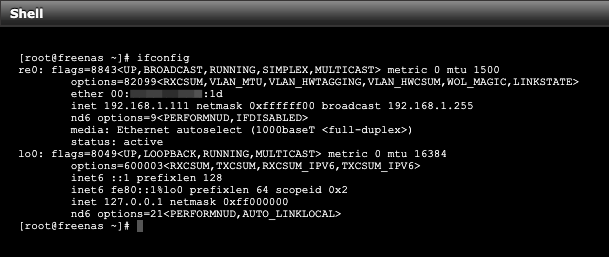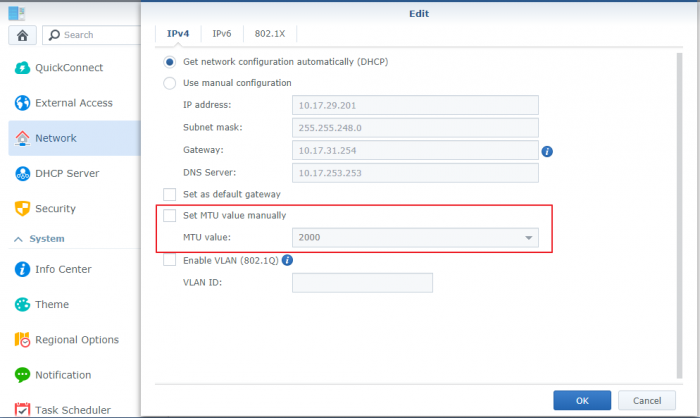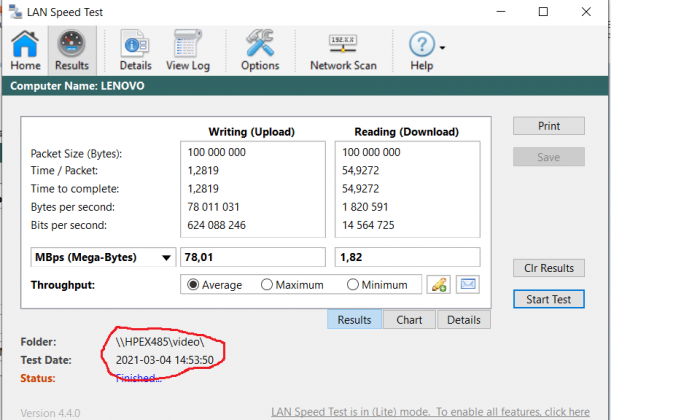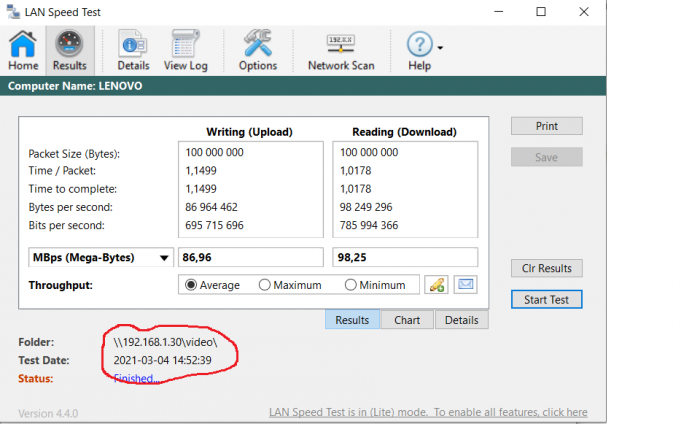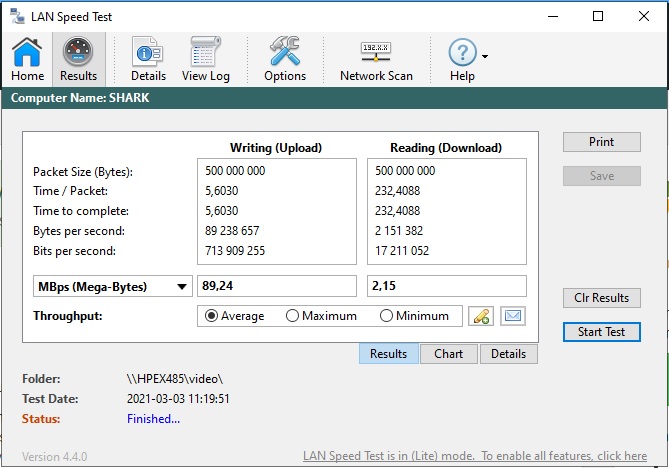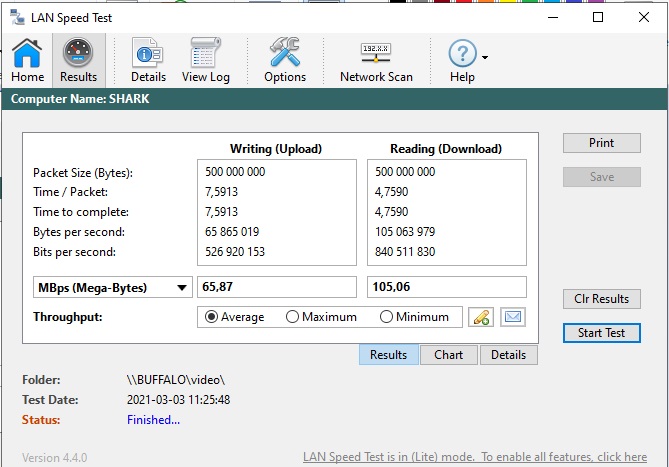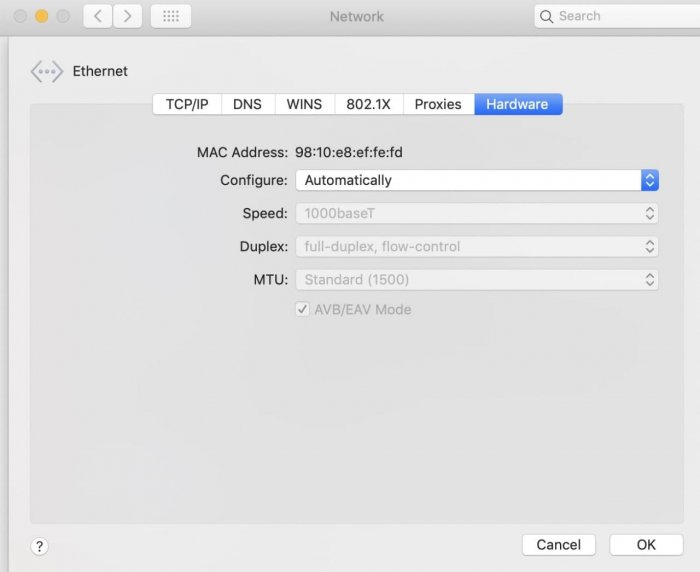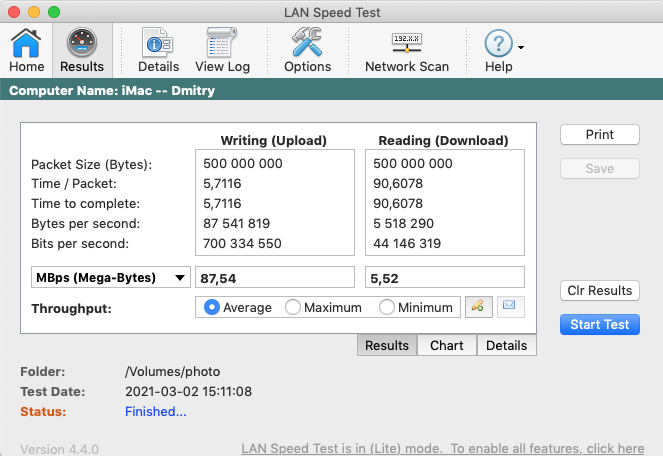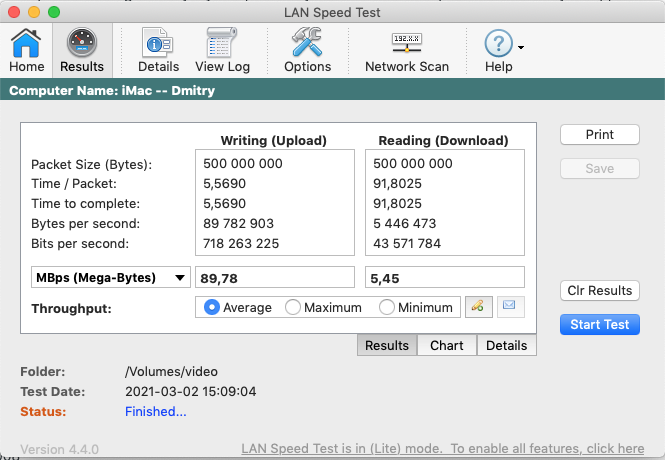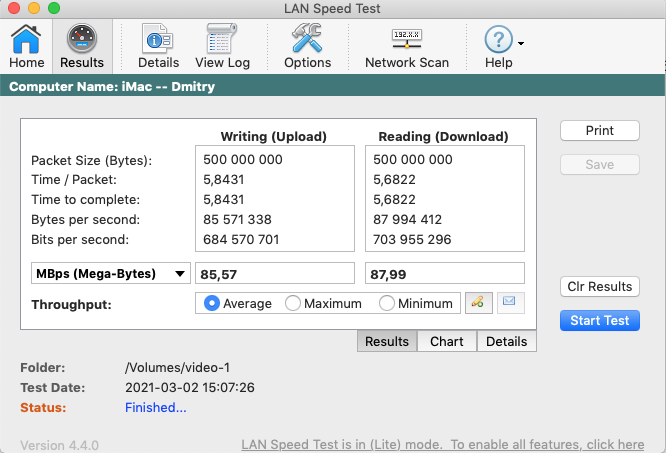
reDDevil
Member-
Posts
35 -
Joined
-
Last visited
Everything posted by reDDevil
-
Slow Speeds
reDDevil replied to syno406's topic in General Post-Installation Questions/Discussions (non-hardware specific)
I checked all my devices in the network. All of them are set automatically to DHCP and have MTU 1500. iMac as well iMac-Dmitry:~ reddevil$ networksetup -getMTU en0 Active MTU: 1500 (Current Setting: 1500) But ifconfig run on iMac shows me one strange interface with MTU 2000 utun0: flags=8051<UP,POINTOPOINT,RUNNING,MULTICAST> mtu 2000 inet6 fe80::d71d:9b73:2477:19ef%utun0 prefixlen 64 scopeid 0xe nd6 options=201<PERFORMNUD,DAD> I don't have any VPN, Tunnelblick or Back to my Mac installed 😕 Anyway this interface can't be a reason, I think -
Slow Speeds
reDDevil replied to syno406's topic in General Post-Installation Questions/Discussions (non-hardware specific)
Why do you recommend me to find correct MTU for internet connection? There is NO any problem with DOWNLOAD speed to DSM, there is a problem of READ speed from DSM to local divices with mtu 1500 set automatically in DSM -
Slow Speeds
reDDevil replied to syno406's topic in General Post-Installation Questions/Discussions (non-hardware specific)
I was revisiting our discussion to give it a second thought and doing some further tests on my system. First of all, it is never enough to show appreciation once again to you guys (flyride, ig-88) for your contribution and help on the matter. Secondly, I think I shall give flyride an extra credit for your critical judgment, whereas critical should for the most part stand for objective and unbiased approach, and where it comes to each of the following: - My conclusions leading to narrowing the problem source down exclusively to DSM are wrong. Or not ultimately right and choiceless to say it another way. At least, by the very idea that one cannot be 100% certain of such unless proven otherwise. Instead, it just seemed to be "obvious" to me. Which isn't the same as "ultimately true". - 2000 MTU is not a standard MTU setting, and shall be potentially avoided by others as a solution indeed. - It can very well be indeed, that there is still an underlying problem with the network setup and behavior. Even if a workaround helps eliminating the issue I'm facing. The biggest issue for me here - for the sake of identifying a true cause of the issue as well as potentially contributing to the community (if, by any means, a flaw is found in the loader build or DSM or driver or whatever) - to find a cause of network issues and I must admit that I feel like I'm in dark, having no clue what to do, as I lack expertise in this. Again I would repeat myself, that I'm willing to devote as much time and effort as can potentially be required to nail this down, providing I (hopefully) get some guidance and suggestions from the community members, who have more expertise in the field (and some time to devote themselves to this). At a same time, I don't need special skills to experiment further, eg with other devices and compare its behavior at least, so this is where I continue to at the moment. I would like to emphasize, that whatever results I'm having and as much as I'm eager to share it here (follows further below) with the community, such shall not be seen as if I'm pushing further my idea of blaming DSM as a source of the issue. However, these findings, albeit indirectly, still can help others as well as give a hint of where the problem really lies. Having said all this, I however think that the same critical and an unbiased approach shall be followed when considering DSM as an alternative potential cause of the problem. Meaning: as well as I might have issues with network, the DSM might have issues, too. One very important note or correction to make here: DSM itself shall be left alone. Its not about it, but rather - about the loader and/or the driver that handles network connection and only IF such is a case. To rephrase: we shall neither exclude my network setup flaw, nor the potential flaw possibility in the loader and/or any such element in this chain, which is responsible for handling the network transport and its parameters and settings. The DSM itself - providing it is not being adjusted during the installation - is taken "as is" from the Synology website, so there indeed could be nothing wrong with it. However, the way how loader and/or DSM handles the hardware it wasn't originally designed for - potentially might cause issues, might it not? As for my findings: - First of all, I've tried to adjust MTU setting back to 1500 in the DSM. Unfortunately, it doesn't work this way. So my previous solution is indeed not a solution, but a workaround of a sort. Probably a valid one, but no more than a workaround, meaning that there still might be a network issue somewhere. - I've taken the effort of installing the FreeNAS 9.10.2 onto my HP ex485. Immediately upon installation that went successfully, I've been receiving "proper" speeds on both read and write without any need to tinker with settings. - The FreeNAS on HP ex485 has an MTU settings of 1500 and it seems to work just fine. I would yet again repeat myself that I'm in no way posting these results to reassure myself and the respectful community members of me being right and to "blame" DSM (or rather, loader) for the issues, but to be fully honest, I think that this at least shall not be disregarded when overviewing the issue on global scale. I hope these finding give us some food for a thought at least, and am wondering what you guys think of it... -
Slow Speeds
reDDevil replied to syno406's topic in General Post-Installation Questions/Discussions (non-hardware specific)
All devices are set to dhcp. Excluding just some of them to have the fixed IP address from the router. No more abnormal manual settings -
Slow Speeds
reDDevil replied to syno406's topic in General Post-Installation Questions/Discussions (non-hardware specific)
Let's go deeper into this issue. I agree to make as much experiments and tests as need with pleasure if it may be useful for community. I just don't know where to seek -
Slow Speeds
reDDevil replied to syno406's topic in General Post-Installation Questions/Discussions (non-hardware specific)
1500 MTU can not be fixed manually in the settings of DSM unfortunately with unknown reason and I don't have enough experience to dig this issue deeper. Of course not. Sorry if I could offend you personally or community by my words. I just want to say that after my experiments as "blind kitten" I could find some threads through google by the request "dsm slow speed mtu" to see that some people found this way also as a decision of the problem. I have no Idea what may be wrong with a whole infrastructure. I gave you several times the explanations that other NASes including original Synology are working perfect in the same infrastructures without any tuning of MTU on them. So what shall I think as an ordinary user? The problem is at the client or at the server? I made a decision that at the server, and manipulations with MTU on DSM prove that. Sorry if I am wrong. But now it works as it should -
Slow Speeds
reDDevil replied to syno406's topic in General Post-Installation Questions/Discussions (non-hardware specific)
I am really sorry for misunderstanding caused because of my bad English. I just wanted to ask if you correctly understood according which adapter (internal or external) I used lspci -k to discover kernel driver used. Ten minutes ago I accidentally found a SIMPLE solution which solved slow reed speed issue to any device in my network (iMac, Windows, SmartTV, etc.) There seems to be a bug with MTU in DSM or a driver. By default the settings are Auto for MTU there but do not work correctly. To fix that it is necessary go to Control Panel / Network / Network Interface Choose LAN 1, then Edit. Tick a box "Set MTU value manually" and choose 1500 MTU value. Press OK. After that you will see that MTU settings are reverted back to Auto. Tick a box "Set MTU value manually" again and choose 2000 MTU value. Press OK. That is all. The MTU will be set manually to 2000 and all issues with low read speed from DSM are gone for any devices in my network. Now DSM works just like "The Fast and the Furious" 😃 It's a pity that finding this solution took a whole week. Hope, my experience will help others in such situation Thank you flyride and IG-88 for a discussion -
Slow Speeds
reDDevil replied to syno406's topic in General Post-Installation Questions/Discussions (non-hardware specific)
Are you sure? That was the answer to flyride on my question how to check current driver for internal NIC (not external AX88179) which I am trying to make working to check my guess with low read speed through internal NIC -
you are right, I can not see the difference. I just can say that the boot process is abnormal with unknown reason when USB NIC is in a port of NAS. And there is no serial port in ex485 unfortunately Thank you for explanation. The only strange thing that I can switch between adapters during installation process but not when DSM is installed 😕 The vid/pid of my USB NIC are 0B95/1790 and I can see it in a "FULL Hardware list support 6.2.0 synoboot DS3615xs" USB https://xpenology.com/forum/topic/34466-full-hardware-list-support-620-synoboot-ds3615xs-usb/ But what does it mean in a situation when I try to use ds3617 6.3.2-25426? ShalI I try to use 6.2 for ds3615? Or 6.3.2 for ds3617 includes it as well
-
I repeated a try to run my server with prepared flash drive for clean installation or with installed DSM through internal NIC with external USB NIC connected many times but none of try was successful LEDs on USB NIC are not blinking and DSM doesn't boot. Probably this is an issue of the hardware or BIOS settings which I can not change because hp ex485 is a headless machine and I can not check what's wrong is going there. How can you explain then that I could get USB NIC working after loading DSM to initial screen through internal LAN as hotplug and I even could make a full setup through USB NIC? When DSM was installed successfully in that way and gone for reboot it didn't boot
-
I tried both variants. Unfortunately DSM does not boot with USB NIC in the port even after successfull installation process. No LEDs, nothing. As soon as I disconnect it from the USB port and connect cable to the internal LAN, the DSM is up and running. But when it is loaded and I am trying to plug-in again the USB NIC nothing happens. No LEDs, no connect to DSM. Tried to use extra.izma 0.11 but it didn't help
-
Hello! Please explain me how I can use correctly the external USB 3.0 LAN adapter with AX88179 chip to make a clean install of ds3617 DSM 6.3.2-25426 (or below) to let it work with that external adapter HP Ex485 MediaSmart server (headless) CPU: Intel Pentium Processor E5200 2M Cache, 2.50 GHz, 800 MHz FSB RAM: 2Gb DDR2 SDRAM 800 Mhz LAN adapter: Realtek 10/100/1000 (Gigabit) RJ45 Ethernet. With DSM 6.3.2 already installed through integrated LAN adapter the external USB doesn't work as "Plug & play", nor with DSM booted nor after reboot. I can not see it as a LAN2 in DSM as well as there is no new client in DHCP list of the router with MAC address of the adapter. If I reboot DSM with USB LAN adapter plugged, the DSM doesn't start anymore unfortunately. After some tries I could make somehow working my USB NIC only in such way: Prepared USB with 1.03b loader with MAC and serial number generated as usually. LAN cable is in internal LAN adapter. When loader is successfully booted, Synology Assistant detected DiskStation (with generated MAC from grub.cfg) and initial page of web assistant is available through browser, I plug my USB NIC into USB port of my server. After that I can see that USB NIC in DHCP list of the router and I can get an access to a web assistant through new IP address provided according to MAC address of USB NIC. But in this way the Synology assistant finds DiskStation with the original MAC address of USB NIC, not which was used in grub.cfg So the question is: can I try to make an installation of DMS with this way discovered? Or after reboot DSM will not start because of some reasons which did not let start DSM when it was already installed? Or I have to change MAC address in grub.cfg before or after installation of DSM to the original MAC address of USB NIC? Or what is the right way? Thank you in advance
-
Slow Speeds
reDDevil replied to syno406's topic in General Post-Installation Questions/Discussions (non-hardware specific)
0000:02:00.0 Class 0200: Device 10ec:8168 (rev 02) Subsystem: Device 10ec:8168 Kernel driver in use: r8168 I can see these records there as soon as I connect an external USB LAN adapter. But I can not see it as a LAN2 in DSM as well as there is no new client in DHCP list of the router with MAC address of the adapter . If I reboot DSM with USB LAN adapter plugged, the DSM doesn't start [176300.759029] usb 2-3: new high-speed USB device number 4 using ehci-pci [176301.219237] ax88179_178a 2-3:1.0 eth1: register 'ax88179_178a' at usb-0000:00:1d.7-3, ASIX AX88179 USB 3.0 Gigibit Ethernet, ##:##:##:##:##:4d -
Slow Speeds
reDDevil replied to syno406's topic in General Post-Installation Questions/Discussions (non-hardware specific)
Well. I have no idea how it is possible but I could reach normal read speed ONLY from Windows (same rj45 outlet and cable as iMac is connected), only through CIFS, and only directly through IP address of DSM. Ie: If I am connecting to DSM as \\192.168.1.30\video the speeds in Lan Speed test and in File Explorer are: 87/98MBps. As soon as I am connected as \\HPEX485\video (ie manually or through Network icon in File Explorer) the speeds are 78/1.82MBps. At the same time, If I am connected to DSM from iMac through smb://192.168.1.30/video and trying to do LAN Speed test or download a file from /video shared folder the speed is dramatically low about 150KBps Also I made a check of downloading speed via browser through File Station: on iMac it is about 6.4MB/s (according to Resource Monitor), on Windows it is about 40MB/s So I do not understand anything what is going wrong there -
Slow Speeds
reDDevil replied to syno406's topic in General Post-Installation Questions/Discussions (non-hardware specific)
But again... A friend of mine (who should join this discussion later) has same issue with absolutely different network setup. He also has lost packets from DSM to his iMac but in addition he has the original Synology where he also has lost packets to iMac but at the same time he has not any complaints for write/read speeds in his network with original Synology -
Slow Speeds
reDDevil replied to syno406's topic in General Post-Installation Questions/Discussions (non-hardware specific)
I tried to connect ex485 to router (excluding switch) but it did not help - read speed came low again -
Slow Speeds
reDDevil replied to syno406's topic in General Post-Installation Questions/Discussions (non-hardware specific)
Hello again. Thank you very much for keeping me updated. I am not sure that this a correct test but I connected NAS directly to my Windows notebook with the same RJ45 cable (no router, no switch between them) and I wish to share the results with you first of all to understand my next steps: I could reach File Station of DSM and downloaded a file from there into Notebook. The download speed was about 32.5MB (according to the Monitoring of DSM). I also checked the speed with LAN speed test software. The read/write speed is 84/92MBps to/from both my DSM pools. As you can see the read speed is much faster in such way. What shall I do next with such test results? -
FULL Hardware list support 6.2.0 synoboot DS3615xs USB
reDDevil replied to Knight_Lore's topic in DSM 6.x
Hello! Please explain me how I can use the external USB LAN adapter with AX88179 chip for DSM 6.3.2-25426 (or below). Can it be used only for clean installation or may be used with installed DSM as well? With DSM installed onto my HP ex485 through internal Realtek LAN adapter the external USB doesn't work as "Plug & play", nor with DSM booted nor after reboot. Since ex485 is a headless server I can not see what is going wrong there during boot. I tried to boot DSM with external USB LAN adapter and 1.03b loader as well with extra.lzma for loader 1.03b ds3617 DSM 6.2.3 v0.11.2_test. No success. As soon as I return cable to internal LAN port - DSM is up and running well. But here is a problem with extremely low read speed from DSM running on ex485. Here is a discussion about it if interested: https://xpenology.com/forum/topic/22165-slow-speeds/page/2/?tab=comments#elControls_195980_menu There is a guess that it may be a problem with integrated Realtek LAN adapter so I wish to make a try to run DSM with external USB LAN adapter but can't understand how to make it working. Any help is very appreciated. -
Slow Speeds
reDDevil replied to syno406's topic in General Post-Installation Questions/Discussions (non-hardware specific)
I suppose that there is a problem with the driver of LAN adapter for my HP ex485 which DSM is trying to use. I would like to try the external USB Lan adapter with AX88179 chipset to confirm or reject that guess but have no idea how to make a try of it. Simple plug & play doesn't work - the DSM doesn't run with that adapter in USB port. Since HP is a headless server I can not check what is going wrong there at the time of boot. Also probably this is a problem of Sata driver which DSM is trying to use with my hardware. But have no idea how to check it Here is the thread of users of HP ex490 installed DSM without any complaints of reading speed (excluding mine) https://xpenology.com/forum/topic/13343-tutorial-install-dsm-62-on-hp-mediasmart-ex485-or-ex490/ But reading this post I understand that ex490 and ex485 use different LAN drivers http://www.mediasmartserver.net/forums/viewtopic.php?t=14496 I then modified /etc/network/interfaces to include an entry for enp3s0, the Realtek driver that 16.04 uses for the 490/495(the 485 uses enp2s0, fwiw) -
Slow Speeds
reDDevil replied to syno406's topic in General Post-Installation Questions/Discussions (non-hardware specific)
reDDevil@HPex485:~$ sudo ping -v -f -c 1000 -s 65507 192.168.1.112 ping: socket: Permission denied, attempting raw socket... ping: socket: Protocol not supported, attempting raw socket... PING 192.168.1.112 (192.168.1.112) 65507(65535) bytes of data. .......................................................................................................................................................................................................................................................... --- 192.168.1.112 ping statistics --- 1000 packets transmitted, 750 received, 25% packet loss, time 4720ms rtt min/avg/max/mdev = 1.437/1.754/2.848/0.243 ms, ipg/ewma 4.725/1.735 ms Ping to Windows desktop: reDDevil@HPex485:~$ sudo ping -v -f -c 1000 -s 65507 192.168.1.104 Password: ping: socket: Permission denied, attempting raw socket... ping: socket: Protocol not supported, attempting raw socket... PING 192.168.1.104 (192.168.1.104) 65507(65535) bytes of data. --- 192.168.1.104 ping statistics --- 1000 packets transmitted, 1000 received, 0% packet loss, time 1679ms rtt min/avg/max/mdev = 1.378/1.505/1.718/0.058 ms, ipg/ewma 1.681/1.505 ms Unfortunately I do not have root access to my TS5400R and it is not easy for my knowledge to obtain that, so at the moment I can not make ping from there. I think we should set aside a ping to iMac issue for the moment. As you can see, there is absolutely 100% ping to Windows desktop but read speed from DSM is even two times worse. First test with HP, second with TS5400R Well, I wrote before my HDD setup with disk models and read results from both pools but I will repeat it once again here as requested with pleasure: I have a BASIC storage pool with single 3TB Seagate HDD ST3000DM001 Also I have SHR storage pool of DSM created from three 1TB disks: WD1002FBYS WD1002FBYS ST1000NM0008 I would like to add that these disks were used perfectly in my HPex485 under Windows Server 2012 before I made a decision to migrate to DSM. Without any issue to read speed. I used it as a media server and I could stream 4K movies to my Smart-TVs without any interruptions. With DSM I can not watch even 360p videos reDDevil@HPex485:~$ sudo dd bs=1M count=512 if=/dev/zero of=/volume1/video conv=fdatasync Password: 512+0 records in 512+0 records out 536870912 bytes (537 MB) copied, 4.26279 s, 126 MB/s reDDevil@HPex485:~$ echo 3 | sudo tee /proc/sys/vm/drop_caches 3 reDDevil@HPex485:~$ dd if=/volume1/video of=/dev/null bs=8k 65536+0 records in 65536+0 records out 536870912 bytes (537 MB) copied, 2.52697 s, 212 MB/s -
Slow Speeds
reDDevil replied to syno406's topic in General Post-Installation Questions/Discussions (non-hardware specific)
Thank you very much for your reply with a try to resolve my issue. Here are the all requested data: HP Ex485: 192.168.1.30 iMac: 192.168.1.112 TS5400R: 192.168.1.10 Gateway (router): 192.168.1.1 Mask: 255.255.255.0 HP Ex485 and TS5400R are set to work in DHCP mode, however, the router has the reservation to provide a fixed specific IP addresses according to their MACs. iMac is in simple DHCP mode DSM offers the choice of using SMB, AFP and NFS file protocols. I'm using AFP & SMB. When connecting from iMac to DSM, using Finder, AFP protocol is used. If I connect DSM server manually through SMB (ie smb://192.168.1.30), the connection in DSM is indicated as CIFS and the read speed is just only about 200KBps (instead of 5MBps through AFP) But again I must to say that read speed problem from DSM is not only on iMac. I have also a Windows 10 desktop with the same problem. Also both of my SMART-TVs can not play normally any video file with even 700MB of size Not sure I can answer this question precisely, as I'm not certain how to properly check it. However, checking via network adapter in the system settings, I see the following: The configuration is "Automatically". Though it doesn't specifically mentions jumbo frames, it is not used as far as I'm concerned. If I'm wrong, could you be so kind to direct me where to check it, please? reDDevil@HPex485:~$ cat /proc/mdstat Personalities : [linear] [raid0] [raid1] [raid10] [raid6] [raid5] [raid4] [raidF1] md2 : active raid5 sda5[0] sdc5[2] sdb5[1] 1943862912 blocks super 1.2 level 5, 64k chunk, algorithm 2 [3/3] [UUU] md3 : active raid1 sdd3[0] 2925444544 blocks super 1.2 [1/1] [U] md1 : active raid1 sda2[0] sdb2[1] sdc2[2] sdd2[3] 2097088 blocks [12/4] [UUUU________] md0 : active raid1 sda1[0] sdb1[1] sdc1[2] sdd1[3] 2490176 blocks [12/4] [UUUU________] unused devices: <none> reDDevil@HPex485:~$ sudo ping -f -c 83333 -s 1472 192.168.1.112 Password: PING 192.168.1.112 (192.168.1.112) 1472(1500) bytes of data. ..............................^C --- 192.168.1.112 ping statistics --- 42631 packets transmitted, 27000 received, 36% packet loss, time 215687ms rtt min/avg/max/mdev = 0.209/0.306/0.561/0.035 ms, ipg/ewma 5.059/0.323 ms The ping is not good as I can see with 36% of lost packets 😕 This is the same command to my Windows desktop: reDDevil@HPex485:~$ sudo ping -f -c 83333 -s 1472 192.168.1.104 PING 192.168.1.104 (192.168.1.104) 1472(1500) bytes of data. .^C --- 192.168.1.104 ping statistics --- 31963 packets transmitted, 31962 received, 0% packet loss, time 9927ms rtt min/avg/max/mdev = 0.143/0.277/11.408/0.099 ms, ipg/ewma 0.310/0.274 ms reDDevil@HPex485:~$ dd if=/dev/zero bs=1M count=1024 | md5sum 1024+0 records in 1024+0 records out 1073741824 bytes (1.1 GB) copied, 2.86019 s, 375 MB/s cd573cfaace07e7949bc0c46028904ff - reDDevil@HPex485:~$ sudo dd bs=1M count=256 if=/dev/zero of=/volume1/video conv=fdatasync 256+0 records in 256+0 records out 268435456 bytes (268 MB) copied, 2.67346 s, 100 MB/s -
Slow Speeds
reDDevil replied to syno406's topic in General Post-Installation Questions/Discussions (non-hardware specific)
I appreciate all and any input provided, and my reply in no way intended to show disrespect or neglect the provided suggestions. Perhaps I was not clear enough (pardon my English for that, as I'm not a native speaker), and yet I made a typo when indicating my write speeds. But for the sake of clarity, I just wanted to explain that the problem I observe doesn't have to do with network misconfiguration or malfunction, to the best of my understanding at least. Should that be a case, I would have experienced both read and write speeds being (too) slow. I would have as well experienced the same on the other devices I have. Neither is the case for me. What is also of secondary concern, is «in general», actual network speeds vs expected given the hardware setup (a rough example here: whether it runs on 80-90 mbps instead of 100-120 is not an issue for me atm). I've double-checked the settings, and I've changed the cable as well and finally, I've tested another NAS that I have connecting it exactly the same way (and using same ports and cables) as my HP - to discover that it gives me way better and correlating speeds on both read and write operations. And the core of my issue with HP is that it gives 'good' or acceptable speed with write operations on to it, and very poor speed ONLY for reading off it. And the latter is beyond any reasonable numbers. Or should I rather say, below. When I said of this problem being not only my own, I actually meant it is not unique with me and my setup, since a friend of mine has absolutely the same issue. I've asked him to contribute to this thread by providing his details in full also. So, to continue and make the issue as clear as possible... My specs of NAS with Xpenology DSM running: HP Ex485 MediaSmart server CPU: Intel Pentium Processor E5200 2M Cache, 2.50 GHz, 800 MHz FSB RAM: 2Gb DDR2 SDRAM 800 Mhz Interface Type: Serial ATA-300 (SATA 3Gb/s) LAN adapter: Realtek 10/100/1000 (Gigabit) RJ45 Ethernet. For Ubuntu it uses enp2s0 driver as I discovered All HDD disks are in perfect condition without any BAD blocks The network is made with Gigabit switch: TP-link TL-SG1024D. HP Ex485 connected to it has 1Gbit LED on as well as iMac where the following LAN speed tests were made from. All tests made with Packet size: 500MB 1st test to a shared folder on BASIC storage pool of DSM created from single 3TB Seagate HDD ST3000DM001 Average writing speed: 89.78MBps Average reading speed: 5.45MBps 2nd test to a shared folder on SHR storage pool of DSM created from three 1TB disks: WD1002FBYS WD1002FBYS ST1000NM0008 Average writing speed: 87.54MBps Average reading speed: 5.52MBps 3rd test to a shared folder on RAID5 created from four Western Digital 2TB WD20EFRX4 disks on my another NAS Buffalo TS5400R (same network, same port on switch, same router and even same RJ45 cable): Average writing speed: 85.57MBps Average reading speed: 87.99MBps Such tests were made also on Windows 10 system with almost same results. As I said before, the downloading a 700MB file from DSM to Windows desktop takes 2 minutes. What other data or tests shall I provide to try help both of us having absolutely same HP servers and issue with slow read speeds? -
Tutorial: Install DSM 6.2 on HP Mediasmart EX485 or EX490
reDDevil replied to jadehawk's topic in Tutorials and Guides
I am sorry. My previous test was wrong through old Wi-Fi. Made a new one on the computer connected to my 1Gbe network. Read speed is around 6MB (which is also shown in DSM monitoring). The downloading file of 720Mb from NAS to desktop takes 2 minutes- 33 replies
-
Slow Speeds
reDDevil replied to syno406's topic in General Post-Installation Questions/Discussions (non-hardware specific)
I am sorry. My previous test was wrong through old Wi-Fi. Made a new one on the computer connected to my 1Gbe network. Write speed is about 90MBps while read speed is only 5.4MBps. (which also shown in DSM monitoring). The downloading file of 720Mb from NAS to dekstop takes 2 minutes The writing and reading speed to/from another Buffalo NAS in my network is 88/88MBps. I tried to change the LAN cable - it did not help. Also I wish to say that it is not my own problem. A friend of mine with the same machine has the same problem with read speed. So it is common and I hope to find a solution with your help. -
Tutorial: Install DSM 6.2 on HP Mediasmart EX485 or EX490
reDDevil replied to jadehawk's topic in Tutorials and Guides
Writing speed is also bad while it is 6x faster than read - 2Mb/s. Anyone with ex485/490 has same problem? A friend of mine with absolutely same HP EX485 installed DSM same date as me and he got the same problem of very slow speeds. Moreover he has the original Synology in his network which is much faster. I have Buffalo NAS and it is fast as well as it should. Something inside DSM or problems with the drivers I think. It is even not possible to stream any video from Plex with such speeds. Any suggestion what to do / test? The benchmark of HDD inside DSM takes a lot of time to test (about 10 minutes) and shows at the end: 172iops / 103 MB/s / 12.8ms- 33 replies
